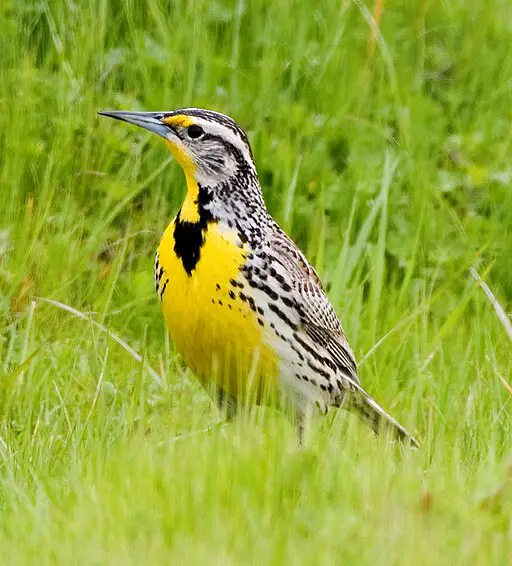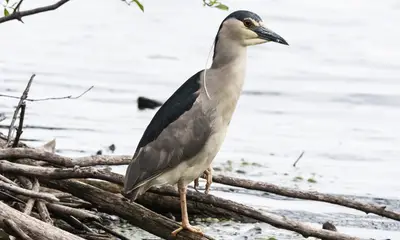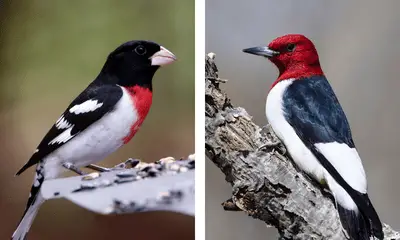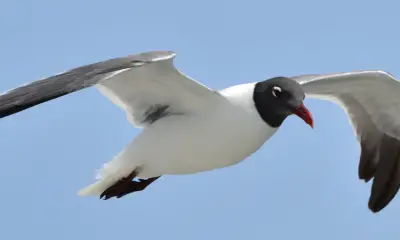11 Types Of PARROTS In Texas (ID Guide With Photos)
Did you recently come across a parrot in Texas, and want to know what species it was?
Identifying parrots in the Lone Star State is not as easy as it might seem, since there are many species of parrots that regularly breed in Texas.
To help you identify the bird you saw, we’ll cover the most common parrots of Texas in this article.

What are the types of parrots in Texas?
The 11 types of parrots commonly found in Texas are:
- Monk Parakeet
- Nanday Parakeet
- Rose-Ringed Parakeet
- Budgerigar
- Green Parakeet
- Red-crowned Parrot
- Red-lored Parrot
- Yellow-headed Parrot
- White-fronted Amazon
- Yellow-crowned Amazon
All of the feral parrots living in Texas are descended from birds that were accidentally introduced by humans.
Some of these species have become established breeding birds in Texas, and can be regularly observed in major urban areas.
Now let’s dive into the details, and take a closer look at each of these species in order to get the full scoop:
Monk Parakeet
Scientific name: Myiopsitta monachus
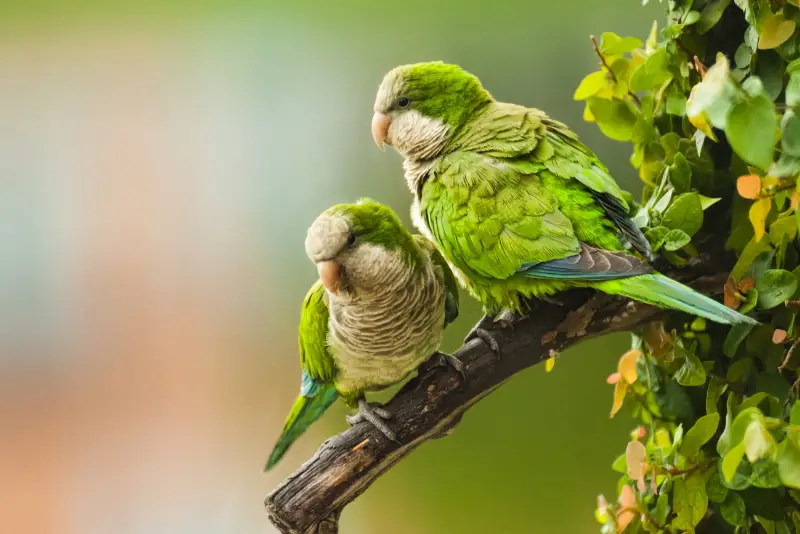
Monk Parakeets are the most common parrots found in Texas, and are present in growing numbers in Houston and Dallas, and several other urban centers of Texas.
Monk Parakeets are also known as Quaker Parrots, and look like miniature macaws with long tails
They have lime green heads and backs, and white underparts. These birds are very social animals, living in groups called flocks.
These birds feed on fruits, berries, buds, flowers, and seeds. During the breeding season, males will compete for mates by making high-pitched whistling sounds.
While these psittacids are regarded as an agricultural pest in their native range in Argentina and other South American countries, they are largely a welcome sight in Texas.
These birds are also the most common parrots in Florida.
Nanday Parakeet
Scientific name: Aratinga nenday
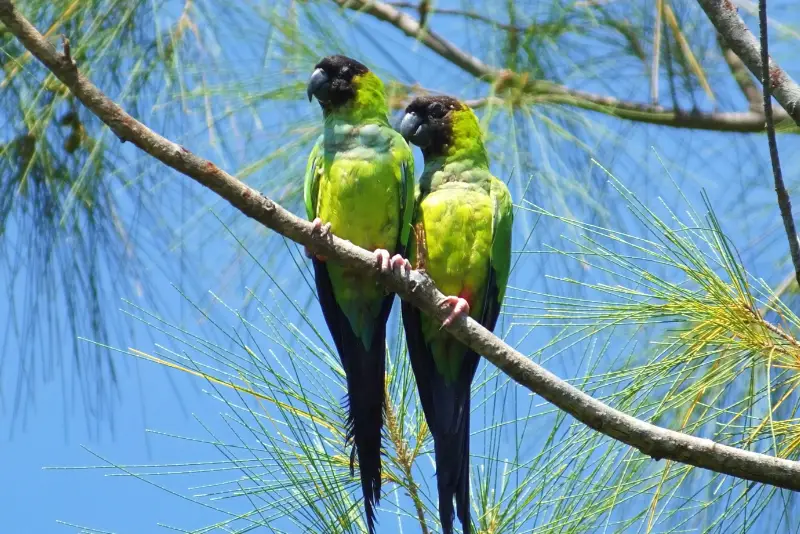
This parrot is a rare breeding bird in several areas in South Texas.
Nanday means “beautiful” in Hindi, and it certainly looks beautiful! This green Texas bird has a black head, green body, and orange feet.
Its tail feathers have red tips. Male birds can weigh up to 1 pound (0.5 kg), while females weigh less than half as much.
The diet of these birds consists mainly of fruit, seeds, nuts, and insects, and they make loud and distinctive squawks at dawn and dusk.
In the Lone Star State, the Nanday Parakeet is most commonly found in the southern part and along the Gulf Coast.
Rose-Ringed Parakeet
Scientific name: Psittacula krameri
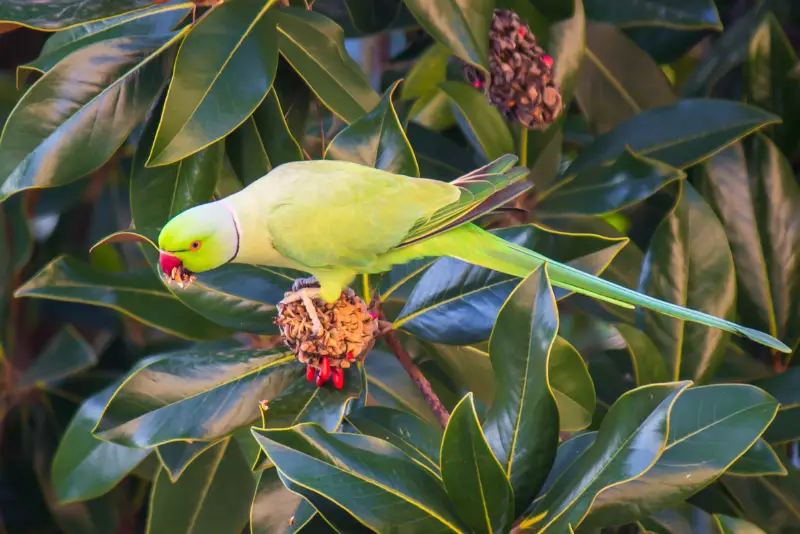
The Rose-ringed Parakeet can be found in small numbers in Texas. These birds are also known as Ring-necked Parakeets because of the distinctive ring on their necks.
These parrots are found in south Texas (such as this Rose-ringed Parakeet filmed in Brownsville, TX), feeding on fruits, seeds, nuts, insects, and worms and nesting in tree cavities.
Originally from India and sub-saharan Africa, escaped birds of this species have successfully colonized many parts of the world, including Northern and Western Europe, the Arabian Gulf, Florida, and Texas.
Budgerigar
Scientific name: Melopsittacus undulatus
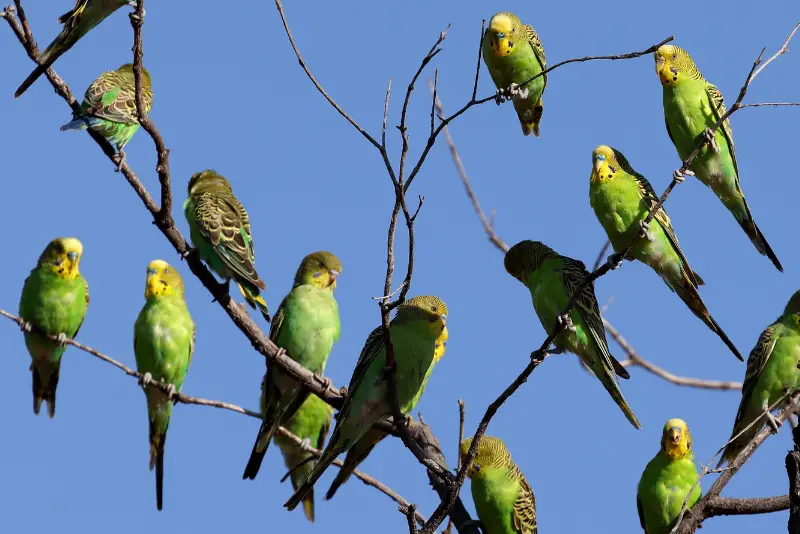
Did you know you can see wild budgies in Texas?
These birds are originally native to Australia and New Guinea, where they were named budgerigars only after non-natives had trouble pronouncing the original name, “gidjirrigaar”, which is a Gamilaraay word.
Although these birds have been given this distinctive (albeit erroneous) name, they also go by the more simple name Common Parakeet, or Shell Parakeet.
Since the 1960s, budgies have been reported breeding in several of Texas’s counties. Budgerigars can be either green, yellow, or light blue, combined with a gray striped back.
They eat insects, spiders, worms, and other invertebrates, and they also love to play with toys!
Green Parakeet
Scientific name: Psittacara holochlorus
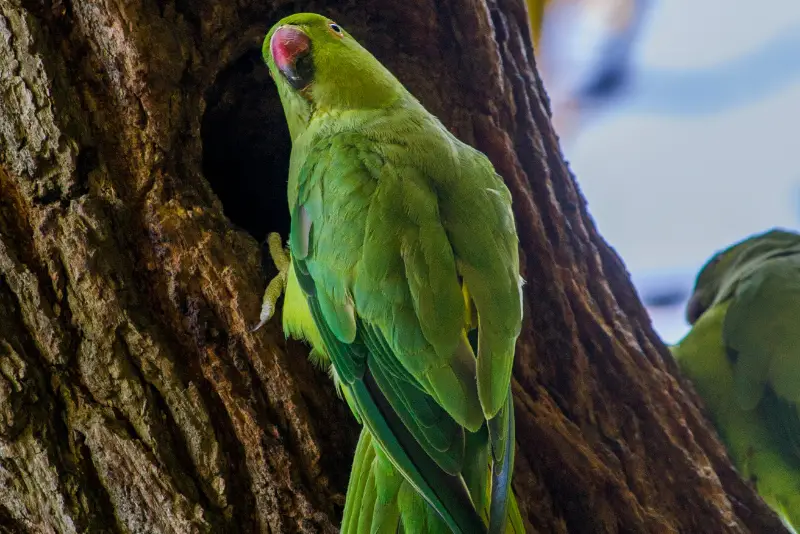
As its name suggests, this parakeet is entirely green, except for a thin black line along its neck, and a bright orange beak.
In Texas, these birds have a breeding population in the Rio Grande valley, although their population size is currently not certain.
It favors swamp forests and woodlands in the wild, but in suburban areas also occurs in royal palm groves.
Red-Crowned Parrot
Scientific name: Amazona viridigenalis
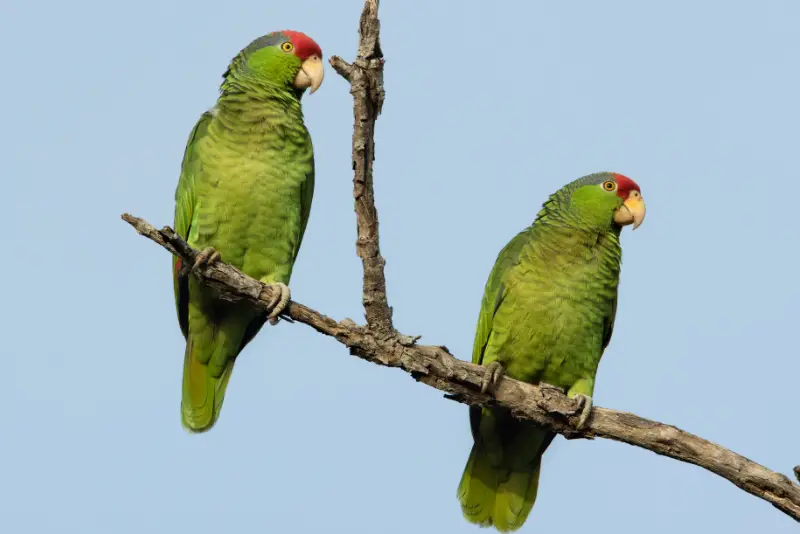
This bird is endemic to the rainforests of Southeast Asia; however, they’re now also found in the Lone Star State, California, Hawaii, and Puerto Rico.
Red-crowned parakeets have red crests on their heads and a yellow belly. They have a long, curved beak, and a yellow throat.
These birds are omnivores, eating fruit, seeds, leaves, nectar, and insects. They prefer to live in dense vegetation and often perch on branches while hunting for food.
Red-lored Parrot
Scientific name: Amazona autumnalis

This parrot species has a characteristic red area between its eyes, which explains its name. It is otherwise largely green, except for a blue gray area on top of its head.
The Red-lored Parrot has established populations in several southern states. It has a small breeding population in southern Texas, but is not as common as other species on this list.
This bird is also one of the parrot species found in California.
Yellow-headed Parrot
Scientific name: Amazona oratrix
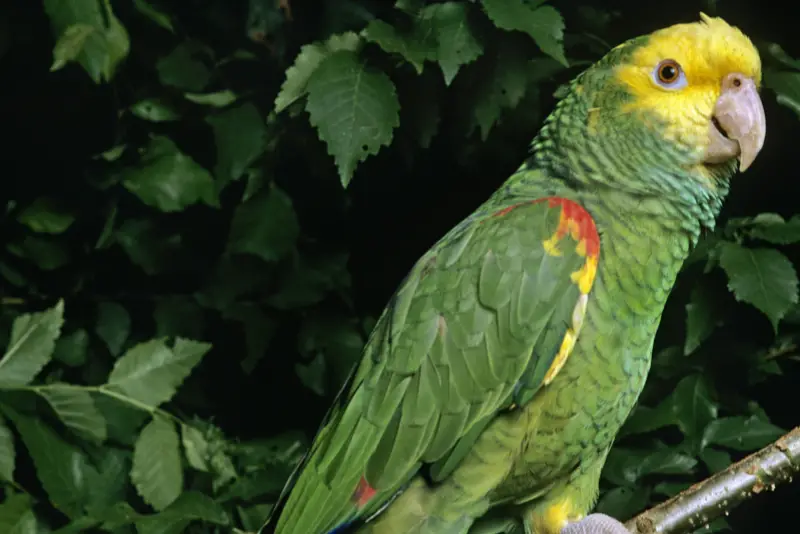
The Yellow-headed Parrot is easily recognizable by its bright yellow head and red patches on its shoulders, which contrast with its green body.
This is an endangered parrot species in its native habitat in South and Central America, and unfortunately the numbers in Texas have also been declining.
White-fronted Amazon
Scientific name: Amazona albifrons
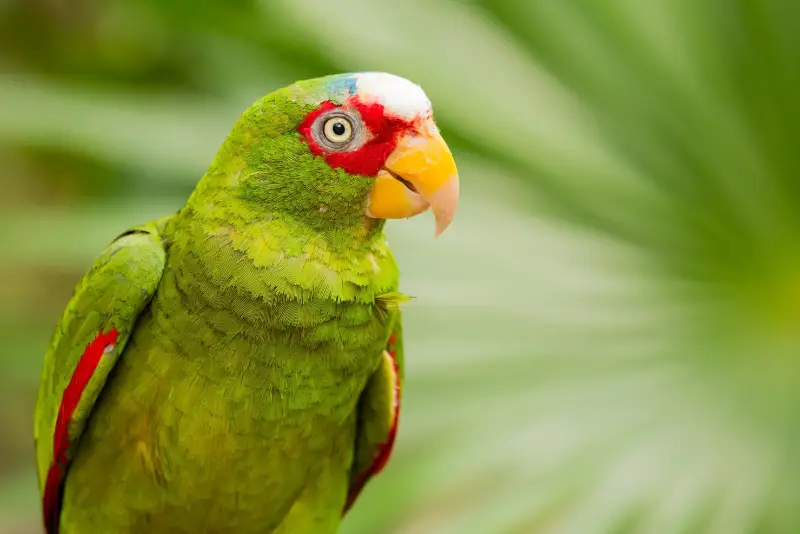
This is the smallest of the Amazon parrots, and resembles a parakeet in size. The best way to identify it is by its white forehead, which is unlike any other similar species.
These birds also have bright red coloring around their eyes, as well as blue plumage on top of their heads.
While it originally hails from Central America, there is now a small feral population breeding in southern Texas.
Yellow-crowned Amazon
Scientific name: Amazona ochrocephala
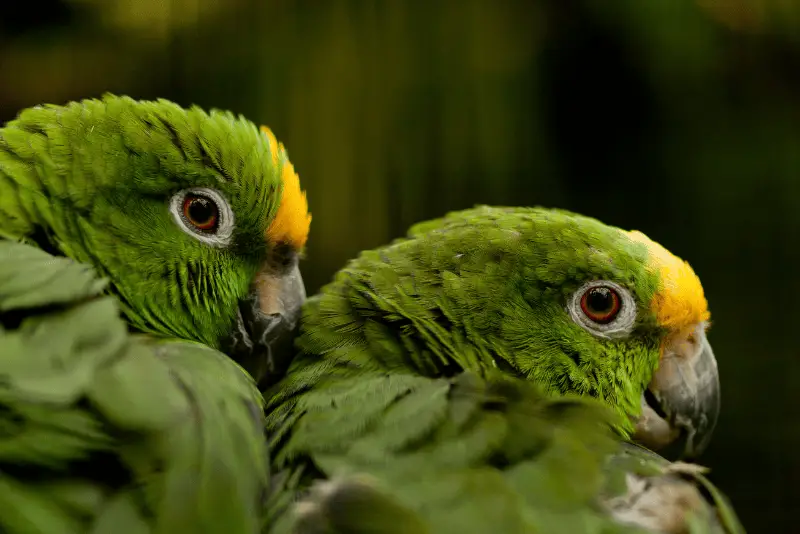
Also known as the Yellow-crowned parrot, this bird is originally native to tropical South America.
While it looks similar to the Yellow-headed Parrot, it can be distinguished by the smaller yellow area on its head, which is restricted to its forehead.
Small numbers of Yellow-crowned Amazons can be seen in Texas in the Rio Grande valley, where they often flock together with other psittacidae.
How did wild parrots get to Texas?
Most of the parrots living in Texas are escaped birds from the pet trade, while others have been introduced by humans on purpose.
None of the parrots that currently breed in Texas are originally native to the Lone Star State.
The success of these introduced birds is probably due to the mild climate in Texas, combined with access to a wide variety of exotic vegetation in urban habitats (including both tropical and subtropical plants).
The only two parrot species that were actually native to Texas are the Carolina Parakeet and the Thick-billed Parrot.
However, the Carolina Parakeet was hunted to extinction more than a hundred years ago, and the Thick-billed Parrot no longer breeds in the US due to habitat loss.
Final Thoughts
More than 25 parrot species have been documented as breeding birds in the USA. Interestingly, all of these 25 species can be encountered in just 3 states: Florida, California, and Texas.
The reason why these three states have the largest diversity of breeding parrots is probably due to their mild climate.
Texas is home to some of the most impressive wildlife on the planet. In addition to its mild climate, the state has a wide range of habitats, from swamps and marshes to urban areas, and beaches along the Gulf Coast.
Because of these favorable conditions, the Lone Star State is home to many exotic birds that are not found anywhere else in North America. Parrots, in particular, seem to be found more and more frequently in Texas.
Parrots are amazing creatures. Although we may not always understand what they’re saying, we do know that they provide us with inspiration and joy when we see a flash of their colorful plumage as they fly by.
If you enjoyed this article, check out our guide to the red birds in Texas.

